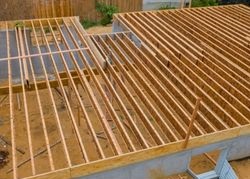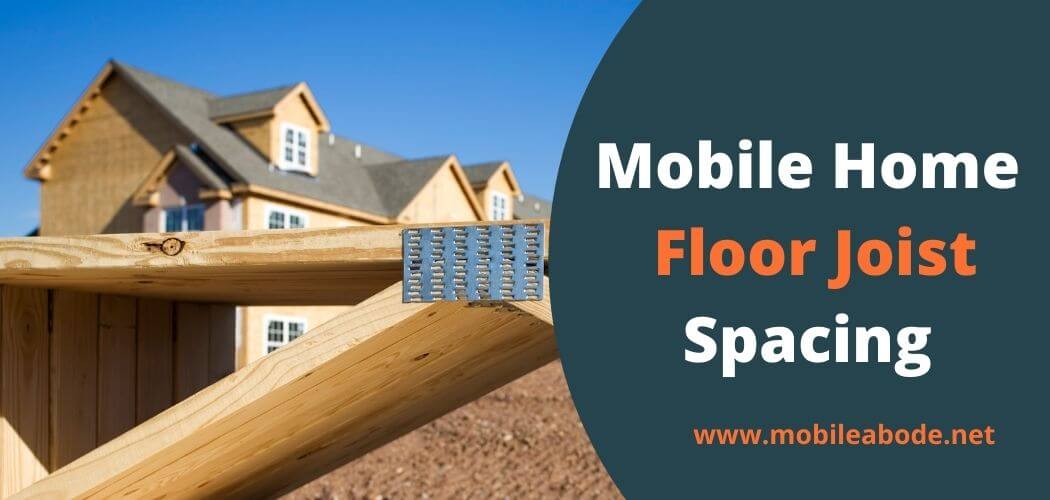After you have determined the size of your mobile home, it is important to know how far apart floor joists are.(bigrentz.com)
The distance between joists will vary depending on the type of home and its age. For example, if a new mobile home has been built with steel beams or wood trusses, then there may be as much as two feet of space in-between each set.

However, for an older model that was constructed using wooden 2x4s spaced at 16 inches on center (OC), then this spacing could be reduced by 1/8th inch per year due to settling over time.
This reduction can cause significant problems because if too close together they will not provide enough room for insulation which could lead to condensation issues.
Mobile Home Floor Joist Spacing
Mobile homes generally have joists that are no more than 16 inches apart. Some can be as close as 12 or 14 inches, but this is very rare and not recommended.
The actual spacing will depend on the manufacturer and type of floor installed (plywood vs. glue down, etc.).
Mobile home builders do make use of deeper floor joists in each room; however, you should never space your joists any further than 16 inches. This may result in an uneven floor surface, which may cause sponginess on one side of the room while feeling hard on the other side.
If you’ve ever walked into a home with wood floors over a concrete slab it’s easy to tell if there is a problem with sub-floor spacing as the floor will feel as though it’s bouncing.
The type of subfloor you have can also play a role in how far your joists are spaced. For example, if you have a traditional wood subfloor, then it is recommended that they be no more than 16 inches apart throughout the entire house.
If you have a metal deck subfloor, however, they should not be spaced closer than 10 inches on center to avoid any elongation or damage from rusting or movement with changes in humidity.
Mobile homes come with one of three types of sheathing with plywood requiring the least amount of spacing at 12″ centers and glued laminated veneer requiring 18″ centers with staggered joints every other course for support with nail pops.
If you have a mobile home that has floor joists that are 24 inches apart or greater or if the subfloor feels bouncy, then it may be time for an upgrade.
Related Article: How Much Does A Mobile Home Weigh?
How long can joists be without support?
When it comes to the length of a floor joist, there is no set rule as there are many variables that will determine how long a joist can be.
The material itself has an effect on the maximum span from supporting wall to wall. Bamboo and many types of plywood could have a standard 1/2″ thick 2’x4′ sheet span between 10′ – 20′. Laminating two sheets together for extra strength will reduce that number even further.
There can be several factors that limit or increase spans including:
- Overall load on the joists (deadweight + live loads)
- Span between fixed objects such as columns, beams or other obstructions
The best way to determine the maximum span of a joist is to calculate it yourself or by getting an engineer.
How far apart should 2×6 floor joists be?

The most common sub-flooring for mobile homes (and cheap flooring in general) is 3/4″ plywood.
3/4″ thick plywood has a rating of approximately 400 lbs. per square foot, which means that any span over 12 feet must be supported by additional framing members such as beams.
As always though it is best to consult an engineer for the most accurate calculations and information before beginning construction.
Must Explore: What Is The Underbelly Of A Mobile Home And Cost To Replace It?
Conclusion:
The floor joists in a mobile home are typically spaced 16 inches in center. This is the standard spacing for these types of homes and it ensures that your floors will be strong and supportive enough to accommodate all sorts of furniture, appliances, and other items you may want to store under them.
If you’re building or renovating a mobile home, keep this important detail in mind as you plan out your layout because there’s no going back once those joists go up!

